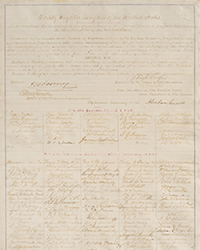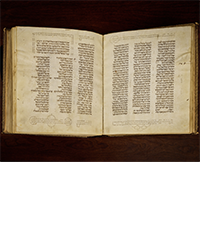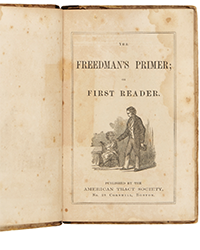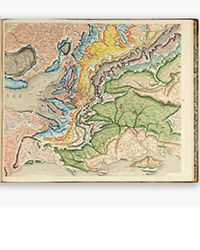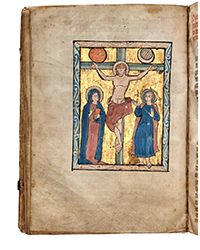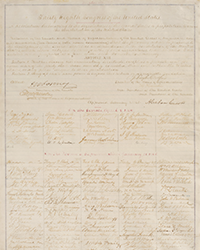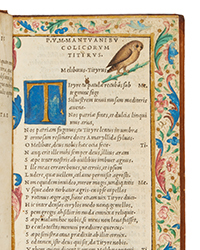Langdon Manor Books has issued their Catalog 13 of The Extraordinary History of the Every Day. Indeed, it's the “every day” aspect of people's lives that often makes them extraordinary. These are items or collections of material from mostly ordinary citizens, not Presidents or Kings, but whose lives touch on the way the rest of us experience life. There are Japanese American citizens whose lives were upended when they were shipped to internment camps during the war, African Americans who experienced challenges in America others do not. There is a letter home from a soldier during the Texas Revolution who did not make it home. There are photo collections, land offerings when the nation was still expanding, a peak at a book store's window display, and much more that touches on the lives of regular people. We can relate, which is what makes it all so special. These are a few samples.
Thomas S. Freeman was a little short of 19 years old when he made the biggest mistake of his short life. He signed up for the Georgia Battalion to fight in the Texas Revolution. He left Macon on November 18, 1835, and headed for Montgomery, Alabama, New Orleans, and then Texas. In a letter dated February 21, 1836, Freeman writes his father from Goliad, Texas. He says that he expects Santa Ana to march on Goliad with 1,500 men to their 500, but they have a good fort and of the Mexican forces, “they are called the greatest cowards in the world.” He continues, “I wished myself at home often in the store (run by his father),” but said he had been promised a job as a clerk in Mobile when he returned. He said that his leader, Col. Ward, told him that that the Georgia Battalion had just three more months to stay before they would return to the United States. Freeman concludes his letter with some poignant words: “I cannot keep from crying when I write these few lines and I think how well I lived at home. And here I am three thousand miles from home like a lost sheep, but if the Lord is willing I hope to see you all again. I am your affectionate son until deth.” Freeman never returned. His battalion was overwhelmed by the Mexicans. They surrendered believing they would be sent back to the U.S. or exchanged for prisoners. Instead, they were taken out in a line on the morning of March 27. They were ordered to halt, whereupon the guards began firing upon them. It was an execution. One man who was able to run and escape recalled being behind Freeman and seeing him fall. Item 43. Priced at $25,000.
The Emancipation Proclamation and Civil War freed the slaves in the South, but they were not so free in reality. In Mississippi, the Black Codes, imposed slightly after the end of the war, placed restraints on the “freedmen.” Among them, was a vagrancy statute that subjected them to fines or imprisonment if they did not have a home. That forced them to seek jobs and shelter, often with their former masters. Item 7 is a sharecropping agreement between Walton and Poates and the “Freedman and Woman Hosea Williams and Eliza his wife.” They were to work for about a year for two bales of cotton weighing 400 lbs. each or an equivalent amount of money, and to be supplied with bacon and corn, which would be deducted from their payment. They were given an hour off of work for dinner in the winter, two in the summer. They were required to rise at daybreak, have their breakfast, and be at work at sunrise. They were to be docked 75 cents for each unexcused absence, such absence to count as a full day off. They would be subject to “An Act to confer Civil Rights on Freedmen,” which did anything but that. It included the vagrancy statute and a provision that said if workers quit during the time of their contract, they would not have to be paid anything for the time they worked. $2,500.
This next item presents another look at the post-Civil War South, both the good and the ugly. It is from 1919, as the Klan was reaching the height of its power. It is a photo from a convention of the International Union of Timber Workers in Meridian, Mississippi. The men in the photo came from Alabama, Mississippi, and Louisiana. There are 32 men, 13 of them white, 19 black. There is some segregation here in that the white men are seated in the front row, the black men standing in back, but the very fact that whites and blacks were fighting for labor's cause together in the South in 1919 is remarkable. Now for the ugly part. Obviously, the Great Southern Lumber Company recognized that this was not only unusual, but something that would upset the white people of Bogalusa, Louisiana. A group of their sympathizers spread this photo around to the white population of the city to turn them against the workers. Racism was sure to work. This followed the infamous Bogalusa massacre, where four union men were killed. Evidently, this was not enough for the lumber company to be confident the union had been completely defeated, as they then distributed this photograph with a caption on the back. Among its inflammatory statements was “HERE YOU ARE! The Southerner may not want it – Bogalusa don't want it - but the South'll get it if it don't watch out. GET WHAT? Social equality, niggers and whites, men and women, all mixed up together like potatoes in one bin.” Item 5. $2,000.
John D. Lyons was a young man raised in New York who graduated from Cornell. Unfortunately, he contracted tuberculosis during his senior year, so his family moved to Tucson in 1927 for his health. For the next four years, he documented what he saw with his camera, particularly in Tucson as well as other places in Arizona and northern Mexico. His pictures give us a look at an area almost a century ago that is now experiencing rapid growth as others move for the warm weather and dry climate. There are numerous Tucson landmarks and events pictured, including Sabino Canyon, University of Arizona, Mt. Lemon, petroglyphs, Tucson Rodeo, and Tucson Indian Training School. Other Arizona locations include the San Xavier Indian Reservation, Roosevelt Dam, and the Casa Grande Ruins. There is a parade and the visit to Tucson by Charles Lindbergh during his Spirit of St. Louis tour. John Lyons decided to stay in Tucson, and went on to be the City Attorney, a Superior Court Judge, and Dean of the U. of A. Law School, and later Professor Emeritus when he died in 1981. Item 13. $3,500.
Next we have a happy family photo album that sadly precedes a very bad time for the family when Americans went insane. It is from a Japanese American family from Vacaville, California, from 1916-1939. Vacaville before the war had a Japanese population of around 25%, and among the residents was the Inai family. They appear to be the typical American-dream family, much smiling as they have get-togethers with extended family. What could possibly go wrong? Sadly, one of the sisters died shortly after the album stopped and a few months later, so did the family matriarch. Then, the following year, came Pearl Harbor, and after that, forced migration to a prison camp. They never came back. Neither did many other Japanese as Vacaville's residents made known they were not welcome. The Inais ended up moving to Milwaukee. Item 28. $5,000.
Langdon Manor Books may be reached at 713-443-4697 or LangdonManorBooks@gmail.com. Their website is found at www.langdonmanorbooks.com.


